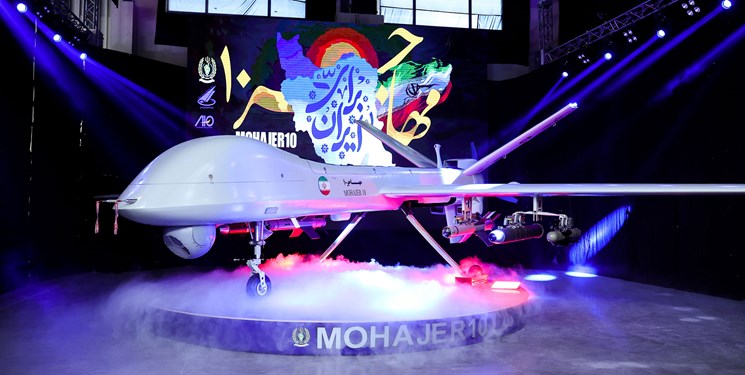On August 22, Iran unveiled a new advanced drone resembling the American MQ-9 Reaper, touting its capability to stay airborne for 24 hours with a range of at least 2,000 kilometers.
Islamic Revolutionary Guard Corps-controlled Fars News Agency released a photo of the Mohajer-10 drone at an exhibition celebrating Defense Industry Day.
In the image, the UAV appears enveloped by a misty ambiance, potentially created by a smoke machine positioned beneath it.
The drone was unveiled in the presence of Iranian President Ebrahim Raisi. The Mohajer 10 boasts a flight endurance of up to 24 hours and can ascend to altitudes of seven kilometers.
“Mohajer,” originating from Farsi, translates to “immigrant.” It has been the label for a series of drones produced by the Islamic Republic since 1985.

Furthermore, the report indicates that the drone holds a maximum fuel capacity of 450 liters while being capable of transporting a maximum payload of 300 kilograms.
Also, the newly developed unmanned aerial vehicle can attain speeds of up to 210 km/h and transport a wide range of ammunition and bombs.
Iran’s hardline President Ebrahim Raisi expressed, “Today, we can firmly introduce Iran as an advanced and technologic nation to the world.”
He emphasized Iran’s commitment to fostering friendly relations with “all nations worldwide,” underscoring that Iran’s armed forces will firmly repel any attempt at invading Iran, as reported by state TV.
State television also published footage of the UAV in action, depicting its takeoff and subsequent landing on the runway. The drone is also reported to be outfitted with electronic warfare and intelligence systems.
The state media also said that in the realm of UAVs, the Iranian defense ministry is actively pursuing the development of the fifth generation of strategic drones through a “drone leap” initiative.
This comprehensive program encompasses the advancement of artificial intelligence, support, electronic warfare, and signal collection missions.
Iran’s Drone To Target Israel’s Nuclear Research Center?
With its declared range of approximately 2000 kilometers, Mohajer’s capabilities raise concerns as Iran could potentially employ this drone to threaten Israel or US forces within the region.
Recently, Iran’s drone prowess has come under significant attention, mainly due to its supply of the Shahed 136 model kamikaze drones to Russia. This latest addition to Iran’s arsenal falls under the classification of long-range UAVs, possessing the capacity to carry substantial payloads, including missiles.
Additionally, in recognition of Iran’s newly introduced UAV, the Mohajer-10, an artistic depiction also emerged on social media.
This portrayal features the drone set against the backdrop of the Israeli nuclear center in Dimona, accompanied by a message inscribed in both Hebrew and Farsi that reads, “Prepare to return to the Stone Age.”
In the image, the drone is also depicted carrying munitions, potentially indicating its intended use to target the facility.
The poster appears to deliver a clear warning, aiming at the Israeli Nuclear Research Center, a tactic reminiscent of Iran’s previous actions when it unveiled the Fattah hypersonic missile and displayed a provocative billboard showcasing then-newly launched missile alongside an unsettling message that stated, “A mere 400 Seconds to Tel Aviv,” thereby directly endangering Israel’s most populous city.
Meanwhile, Iran has been producing these types of drones for several years, often attempting to replicate other models, including those from the US. Iran’s existing Shahed drone family includes the Shahed 129, which resembles the recently unveiled Mohajer-10.
Over the past few years, Iran has introduced a series of drones that it claims are capable of long-endurance flights, yet their actual role in combat scenarios remains uncertain.
However, some Iranian drones, including Shahed-136 loitering munition, have played a pivotal role in Russia’s ongoing conflict in Ukraine.
Tehran’s explanations have been inconsistent; initially, they denied supplying these drones to Moscow but later asserted that the sales occurred only before the special military operation in Ukraine.
Furthermore, these drones are anticipated to boost Iran’s defense industry, potentially serving as a means of international sales.
Nonetheless, despite the drones bearing similarities in appearance with US-made UAVs, Iran has consistently grappled with challenges in matching the same level of endurance or capabilities in its drone manufacturing endeavors.
- Contact the author at ashishmichel(at)gmail.com
- Follow EurAsian Times on Google News